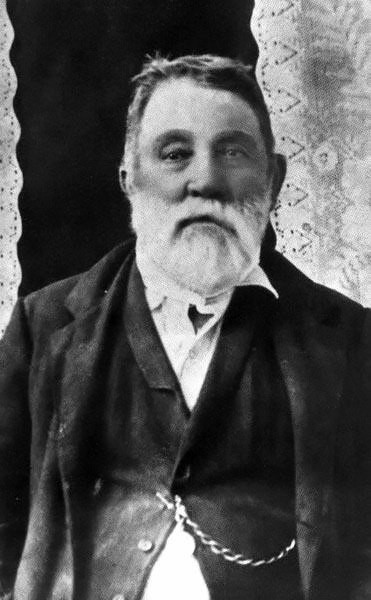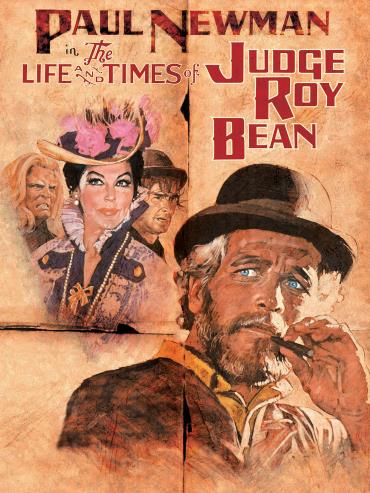



Roy Bean, Judge, Lawman, San Diego Fugitive
Old West lore remembers Judge Phantly “Roy” Bean as “The Law West of the Pecos.” Western films and books – often filled with stories from Bean himself – portray him as a hanging judge who held court in the Jersey Lilly Saloon in Langtry Texas. In reality, the self promoting legend only sentenced two men to hang and one of them escaped.
As a magistrate - with no formal legal education - "Judge" Roy Bean did not allow hung juries or appeals. Jurors were chosen from his best bar customers and were expected to buy a drink during every court recess.
Judge Bean was also known for his unusual rulings. In one case, an Irishman named Paddy O'Rourke shot a Chinese laborer. A mob of 200 angry Irishmen surrounded the courtroom and threatened to lynch Bean if O'Rourke was not freed. After looking through his law book, Bean ruled that "homicide was the killing of a human being; however, he could find no law against killing a Chinaman". The case against Paddy was dismissed.
So what was his connection to San Diego? For that the Crime Files time machine goes back to May 1850. California was about to join the union as 31st state in America. The state capital was San Jose and California’s southernmost city, San Diego, was a dusty little town of a few square miles.
Incorporated on March 27, 1850, city voters elected 32-year-old Joshua Bean as its first mayor. Joshua and his 25-year-old brother, Roy had arrived in town about a year prior after working as a trader and saloon owner in Baja California. Unbeknownst to many San Diegan’s was Roy was already a wanted man. In 1848 he’d shot and killed a Mexican who had threatened "to kill a gringo."
While his brother was popular with the electorate, Roy was more interested in the ladies. Those proclivities invariably led to a confrontation with other men in town. The most notorious was a Scotsman named Collins who challenged Bean to a horseback duel. Despite being a common way of settling differences, dueling was not legal. The gunfight took place on February 24, 1851, in the Old Town Plaza and ended with Collins' receiving a wound to his right arm.
City Marshal Agoston Haraszathy quickly arrested both men and charged them with assault with intent to commit murder. In the two months he was in jail, Roy Bean received flowers, food, wine and cigars from local women. One of those gifts was knives encased in tamales which Bean used to dig through the cell wall of the adobe and rock jail. It would be the last time he was seen in San Diego.
The escape ushered in a town scandal that ultimately brought the city to its collective knees. The ease at which Bean escaped proved the jail, built at a cost of more than $5,000 by Marshal Haraszathy himself, was substandard. To remedy the situation, the Marshal approached the town council and requested an additional $2000 to “fix it.” Led by his father Charles, a member of the town council, the motion was approved.
Between his $1000 annual salary, the $5000 jail construction and the additional $2000 of repairs, Agoston was now into the city for $8000 of its entire $10,000 treasury. All of this was on top of the $2.50 the marshal charged the city to house prisoners!
The cumulative cost ultimately bankrupted the city.
Concerned about incompetent leadership, state officials revoked the city charter and established a state controlled board of trustees to manage civic affairs. It would be almost 40 years before the state trusted the locals enough to allow them to run their own city.
Meanwhile, Roy Bean moved to San Gabriel where he became a bartender for his brother's saloon, known as the Headquarters. When Joshua Bean was murdered in a robbery gone bad on November 7, 1852, Roy inherited the saloon.
In 1854, Bean courted a woman who was later kidnapped and forced to marry a Mexican military officer. In response, Bean challenged the groom to a duel and killed him.
Six of the dead man’s friends ultimately caught Bean, threw a noose around his neck then left him to hang. Fortunately for Bean his captors didn’t stay to watch his demise and the bride, who had been hiding behind a tree, cut the rope and saved his life. Bean was left with a permanent rope burn on his neck and a permanent stiff neck.
Roy Bean soon migrated to New Mexico where he and a partner operated a merchandise store and saloon in present-day Grant County, New Mexico. The saloon advertised liquor and "a fine billiard table." A cannon belonging to Roy sat in front of the store for show. Supposedly it was used to repel an Apache assault on the town.
When Bean arrived in Langtry Texas he quickly found a town ripe for the pickens. After getting himself elected Justice of the Peace, Roy quickly established a courthouse and began dispensing justice. Since the town did not have a jail, all cases were settled by fines. Bean refused to send the state any part of the fines, but instead kept all of the money. Ironically, most of the fines were made for the exact amount that happened to be in the accused's pockets at the time
Horse thieves, often sentenced to death in other jurisdictions, were always let go if the horses were returned.
Although only district courts were legally allowed to grant divorces, Bean did so anyway, pocketing $10 per divorce. He charged only $5 for a wedding and ended all wedding ceremonies with, "may God have mercy on your souls" (traditionally the end of a death sentence).
Bean won re-election in 1884, but was defeated in 1886. The following year, the commissioner's court created a new precinct in the county and appointed Bean the new Justice of the Peace. He continued to be elected until 1896. Even after that defeat, he "refused to surrender his seal and law book and continued to try all cases north of the tracks.
Despite his shady past as Bean aged he spent much of his profits to help the poor of the area and always made sure that the schoolhouse had free firewood in winter.
He died in his sleep on March 16, 1903, after a bout of heavy drinking in San Antonio.




"Roy Bean" in his early years
In 1972 Paul Newman starred in the Life and Times of Judge Roy Bean. The film was awarded 3 Academy Awards